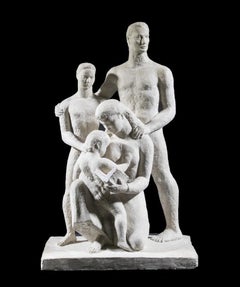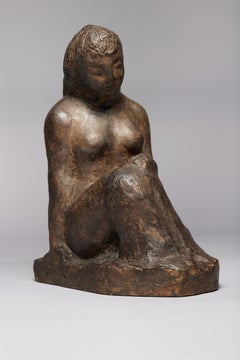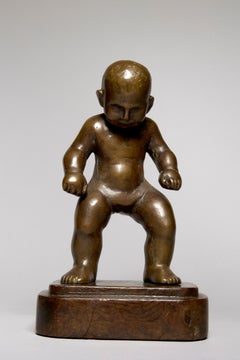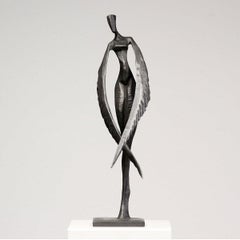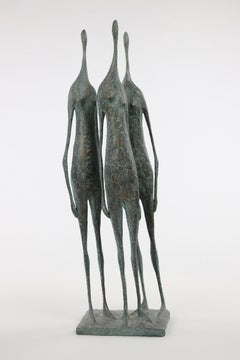William Zorach Sculptures
American, 1887-1966
Born in 1887, by 1930, he was one of America’s premier 20th century sculptors and was honored with multiple commissions and exhibitions including at the Art Institute of Chicago, the Dallas Museum of Fine Art, the Whitney Museum of American Art, and numerous others.
He studied in New York City at the National Academy of Design and also in Paris under the mentoring of Jacques-Emile Blanche. It was in Paris in the first decade of the 20th century where Zorach’s path crossed with Marguerite, his soon to be wife. Both Marguerite and William were both represented in the landmark Armory Show of 1913.
William continued to paint for the next two decades, but increasingly experimenting with sculpture. By the mid 20’s he was carving significant works in marble and stone. By the early 30’s, he abandoned painting entirely in favor of a new art form, sculpture. I t was in sculpture that Zorach found his true voice as an artist and achieved considerable success. “Sculpture, direct carving, was an expanding universe, a liberation and a natural form of expression to me.” Zorach stated.
Museum Collections:
Amon Carter Museum of American Art
Arizona State University Art Museum
Boca Raton Museum of Art
Butler Institute of American Art
Cleveland Artists Foundation
Colorado Springs Fine Arts Center
Cornish Colony Museum
Dallas Museum of Art
Delaware Art Museum
Edwin a Ulrich Museum of Art
Farnsworth Art Museum
Flint Institute of Arts
Frederick R Weisman Art Museum
Georgia Museum of Art
Herbert F Johnson Museum of Art
Jack S Blanton Museum of Art
LaSalle University Art Museum
Los Angeles County Museum of Art
Lowe Art Museum
Marion Koogler McNay Art Museum
Memorial Art Gallery
Metropolitan Museum of Art, NYC
Middlebury College Museum of Art
Minneapolis Institute of Arts
Mobile Museum of Art
Museum of Fine Art-Boston
Pennsylvania Academy of the Fine Arts
Portland Museum of Art
Smithsonian Museum of Art
The Brooklyn Museum of Art
The Canton Museum of Art
The Columbus Museum of Art-Ohio
The Columbus Museum-Georgia
The Cummer Museum Of Art & Gardens
The Currier Museum of Art
The Nelson-Atkins Museum of Art
The Newark Museum
The Phillips Collection
The Phillips Museum of Art
The University of Michigan Museum of Art
Whitney Museum of American Art
Worcester Art Museum
Yosemite Museum
to
2
1
Overall Width
to
Overall Height
to
3
1
1
1
3
2
2
2
1
1
1
1
1
1
2
1
1
9
214
196
162
132
3
Artist: William Zorach
"Pioneer Family" WPA American Modernism Plaster Maquette Realism 20th Century
By William Zorach
Located in New York, NY
"Pioneer Family," 23 1/2 x 16 1/4 x 10 3/4 inPlaster. c. 1927. Unsigned. Realism
The Smithsonian has a cast of this sculpture in its collection. Pictured on the cover of “The Sculpt...
Category
1920s American Modern William Zorach Sculptures
Materials
Plaster
Seated Nude Woman Sculpture, Early 20th Century
By William Zorach
Located in Beachwood, OH
William Zorach (American, 1887-1966)
Seated Woman
Painted plaster
Inscribed underside "V"
12.5 x 9 x 5 inches
Provenance: The Tatti Family Collection
Bill Zorach was born in Lithuan...
Category
Early 20th Century William Zorach Sculptures
Materials
Plaster
First Steps, Early 20th Century Bronze Sculpture, Cleveland School
By William Zorach
Located in Beachwood, OH
William Zorach (American 1891-1966)
First Steps, 1918
Bronze
8.5 x 5 x 4 inches, including base
Born in 1887 in Lithuania, William Zorach immigrated with his family to the United States when he was just four years old, settling in Cleveland, Ohio. Zorach displayed an exceptional artistic talent at a young age and, at the recommendation of his seventh-grade teacher, began studying lithography at night at the Cleveland School of Art. It was not long before he was apprenticing at a lithography company in Cleveland. It was there that he realized he wanted to become an artist - to escape the commercial end of the field in which he was suddenly immersed.
In 1907, Zorach saved enough money to move to New York and study art at the National Academy of Design, where he received several awards for his paintings and drawings. He continued his studies in Paris in 1910 at La Palette. This year abroad would turn out to be quite fruitful because in Paris he was greatly influenced by the Cubist and Fauvist movements and had several paintings exhibited at the Salon d'Automme. This influence and subsequent success fueled his career back in the states where he was honored with his first one-man exhibition. Due to this new-found stability, he married a young woman he met at school in Paris, and they moved to New York and set up a studio. Shortly after, their work was accepted into the famous 1913 Armory Show.
For the next nine years, Zorach continued to think of himself as a painter, although he had already begun to experiment in sculpting. He was experiencing modest success with his painting and was therefore reluctant to abandon it completely. However, he was impelled toward sculpting, and in 1922, he painted his last oil.
Zorach's involvement with sculpture began largely be accident. While he was working on a series of wood-block prints, Zorach suddenly became more interested in the butternut panel than the print and turned the panel into a carved relief. With no formal training as a sculptor, Zorach's first sculptures were of wood and his carving tools were primitive, such as a jack-knife. I n fact, his early works have a certain stylized look, suggesting the influence of various primitive arts such as African and American folk.
Zorach found his sculptural direction by instinct, but was not unaware of what other sculptors were doing, both here and abroad. He soon allied himself with a growing number of modern sculptors who believed in the esthetic necessity of carving their own designs directly in the block of stone or wood rather than modeling them in clay. From the beginning he found a deep satisfaction in the slow and patient process of freeing the image from its imprisoning block, watching the forms emerge and appear.
"The actual resistance of tough material is a wonderful guide," Zorach said in a lecture on direct sculpture in 1930. The sculptor "cannot make changes easily, there is no putting back tomorrow what was cut away today. His senses are constantly alert. If something goes wrong there is the struggle to right the rhythm. And slowly the vision grows as the work progresses." Zorach also found that the material itself had a constantly modifying effect on the artist's vision. The grain of the wood, the markings in the stone, the shape of the log or boulder all set limits and suggested possibilities. He was always sensitive to the characteristic qualities of his material and occasionally let them play a major role in determining his forms. In works such as these, the feel of the original material is preserved in the finished piece and is often heightened by leaving parts of the original surface untouched and other areas roughly marked by the sculptors tools...
Category
1910s William Zorach Sculptures
Materials
Bronze
Related Items
Fleur – Charlotte by Nando Kallweit. Elegant bronze figurative sculpture
By Nando Kallweit
Located in Coltishall, GB
Fleur – Charlotte is an elegant figurative bronze sculpture by Nando Kallweit.
Inspired by the the legend of the phoenix, this female figure has graceful wings instead of arms. The...
Category
21st Century and Contemporary Other Art Style William Zorach Sculptures
Materials
Bronze
$1,582
H 11.82 in W 2.56 in D 4.73 in
3 Standing Figures V by Pierre Yermia - Contemporary bronze sculpture, human
By Pierre Yermia
Located in Paris, FR
3 Standing Figures V is a bronze sculpture by French contemporary artist Pierre Yermia, dimensions are 63 × 18 × 14 cm (24.8 × 7.1 × 5.5 in).
The sculpture is signed and numbered, i...
Category
2010s Contemporary William Zorach Sculptures
Materials
Bronze
$7,618
H 24.81 in W 7.09 in D 5.52 in
Nude
By Ybah
Located in Pasadena, CA
After studying fine arts, a need for contact with solid material was needed. Ybah took a classic artistic path from an academic education from the Louvre reproductions, learning at t...
Category
20th Century William Zorach Sculptures
Materials
Bronze
Young Goatherder Bronze Sculpture by Oscar Gladenbeck, circa 1900
Located in Rochester, NY
Bronze statue of young goatherder by Oscar Gladenbeck. circa 1900. Signed "Oscar Gladenbeck Friedrichshagen".
period sculpted artist sculpture
collectio...
Category
Early 20th Century Renaissance William Zorach Sculptures
Materials
Bronze
$1,350
H 11.5 in W 4.75 in D 2.5 in
Danseuse "Elancée" II by Yann Guillon - Dancer bronze sculpture, ballet, woman
By Yann Guillon
Located in Paris, FR
Danseuse "Elancée" II is a bronze sculpture by contemporary artist Yann Guillon, dimensions are 28 cm × 21 cm × 4 cm (11 × 8.3 × 1.6 in). Dimensions of the metal base: 13 cm x 8 cm x...
Category
2010s Contemporary William Zorach Sculptures
Materials
Bronze
$2,578
H 11.03 in W 8.27 in D 1.58 in
19th century French Bronze of a naked woman standing up.
Located in Woodbury, CT
Well modeled 19th century French bronze of a standing naked woman.
Signed Cartinet, this piece is a wonderful example of the skill of a Sculptor.
The piece retains all its origina...
Category
1890s Victorian William Zorach Sculptures
Materials
Bronze
$1,356 Sale Price
20% Off
H 12 in W 4 in
Janne by Nando Kallweit. Elegant figurative sculpture.
By Nando Kallweit
Located in Coltishall, GB
Janne is an elegant figurative bronze sculpture by Nando Kallweit.
Modelled on modern youthful postures but with a nod to the importance of heritage through the stylised Egyptian-in...
Category
21st Century and Contemporary Other Art Style William Zorach Sculptures
Materials
Bronze
$697
H 6.3 in W 2.37 in D 3.55 in
Pair of 19th century scagliola sculptures (Italian Neoclassicism) - Roman figure
Located in Varmo, IT
Pair of scagliola sculptures - Roman figures. Italian manufacture, 19th century.
51 x 26 x h 118 cm (left) - 41 x 28 x h 118 cm (right).
Made entirely of scagliola. Depicting two f...
Category
Early 19th Century Old Masters William Zorach Sculptures
Materials
Plaster
$5,625 Sale Price
20% Off
H 46.46 in W 20.08 in D 10.24 in
Chaim Gross Mid Century Mod Bronze Sculpture Mother and Baby Playing WPA Artist
By Chaim Gross
Located in Surfside, FL
Chaim Gross (American, 1904-1991)
Cast bronze sculpture
Caring (or Mother and Child)
signed
Mounted on wooden plinth
Featuring a mother raising her child up in superb high relied i...
Category
Mid-20th Century American Modern William Zorach Sculptures
Materials
Bronze
$2,400
H 9 in W 7.5 in D 3.5 in
Hoop Dancer
By Demetre Chiparus
Located in Los Angeles, CA
Demetre Haralamb Chiparus (also known as Dumitru Chiparus) (16 September 1886 in Dorohoi, Romania - 22 January 1947 in Paris, France) was a Romanian Art Deco* era sculptor who lived and worked in Paris.
He was born in Romania, the son of Haralamb and Saveta. In 1909 he went to Italy, where he attended the classes of Italian sculptor Raffaello Romanelli. In 1912 he traveled to Paris to attend the Ecole des Beaux Arts* to pursue his art at the classes of Antonin Mercie and Jean Boucher.
Demetre Chiparus died in 1947 and was buried in Bagneux cemetery, just south of Paris.
The first sculptures of Chiparus were created in the realistic style and were exhibited at the Salon of 1914. He employed the combination of bronze and ivory, called chryselephantine*, to great effect. Most of his renowned works were made between 1914 and 1933. The first series of sculptures manufactured by Chiparus were the series of the children.
The mature style of Chiparus took shape beginning in the 1920s. His sculptures are remarkable for their bright and outstanding decorative effect. Dancers of the Russian Ballet, French theatre, and early motion pictures were among his more notable subjects and were typified by a long, slender, stylized appearance. His work was influenced by an interest in Egypt, after Pharaoh Tutankhamen's tomb was excavated.
He worked primarily with the Edmond Etling and Cie Foundry in Paris administrated by Julien Dreyfus. Les Neveux de J. Lehmann was the second foundry which constantly worked with Chiparus and produced the sculptures of his models.
Chiparus rarely exhibited at the Salon. In 1923 he showed his Javelin Thrower, and in 1928 exhibited his Ta-Keo dancer. During the period of Nazi persecution and the World War II, the foundries discontinued production of work by Chiparus. The economic situation of that time was not favorable to the development of decorative arts and circumstances for many sculptors worsened.
Since the early 1940s almost no works of Chiparus were sold, but he continued sculpting for his own pleasure, depicting animals in the Art Deco style. At the 1942 Paris Salon, the plaster sculptures Polar Bear and American Bison were exhibited, and in 1943 he showed a marble Polar Bear and plaster Pelican.
Sculptures of Dimitri Chiparus represent the classical manifestation of Art Deco style in decorative bronze ivory sculpture. Traditionally, four factors of influence over the creative activity of the artist can be distinguished: Serge Diaghilev's Ballets Russes, ancient Egyptian art, and French theatre. Early motion pictures were among his more notable subjects and were typified by figures with a long, slender, stylized appearance. Some of his sculptures were directly inspired by Russian dancers.
Quite often, Chiparus used the photos of Russian and French dancers, stars and models from fashion magazines of his time.
After the tomb of Tutankhamun was discovered in 1922, the art of ancient Egypt...
Category
1920s Art Deco William Zorach Sculptures
Materials
Marble, Bronze
Life-size Plaster Statue of The Callipygian Venus or Aphrodite 1920'
Located in Rome, IT
Italian life-size plaster sculpture , figure of the Callipygian Venus, after the antique Roman marble statue.
Aphrodite Kallipygos, or Callipygian Venus literally means “Venus of ...
Category
1920s Academic William Zorach Sculptures
Materials
Plaster
$8,438 Sale Price
20% Off
H 70.87 in Dm 23.63 in
Large Grand Tour Bronze Greco-Roman Uffizi Wrestlers Ferdinand Barbedienne
By F. Barbedienne Foundry
Located in Rochester, NY
Grand tour circa 1860s bronze of the Wrestlers. Rich fine dark brown patina. Marked "F. Barbedienne Fondeur." The Wrestlers also known as The Two Wrestlers, The Uffizi Wrestlers...
Category
Mid-19th Century William Zorach Sculptures
Materials
Bronze, Metal
$11,000
H 18.5 in W 22.5 in D 14 in
William Zorach sculptures for sale on 1stDibs.
Find a wide variety of authentic William Zorach sculptures available for sale on 1stDibs. You can also browse by medium to find art by William Zorach in bronze, metal, plaster and more. Much of the original work by this artist or collective was created during the 20th century and is mostly associated with the modern style. Not every interior allows for large William Zorach sculptures, so small editions measuring 16 inches across are available. Customers who are interested in this artist might also find the work of Dudley Vaill Talcott, Brad Rude, and Stanley Bleifeld. William Zorach sculptures prices can differ depending upon medium, time period and other attributes. On 1stDibs, the price for these items starts at $31,200 and tops out at $40,000, while the average work can sell for $35,600.
